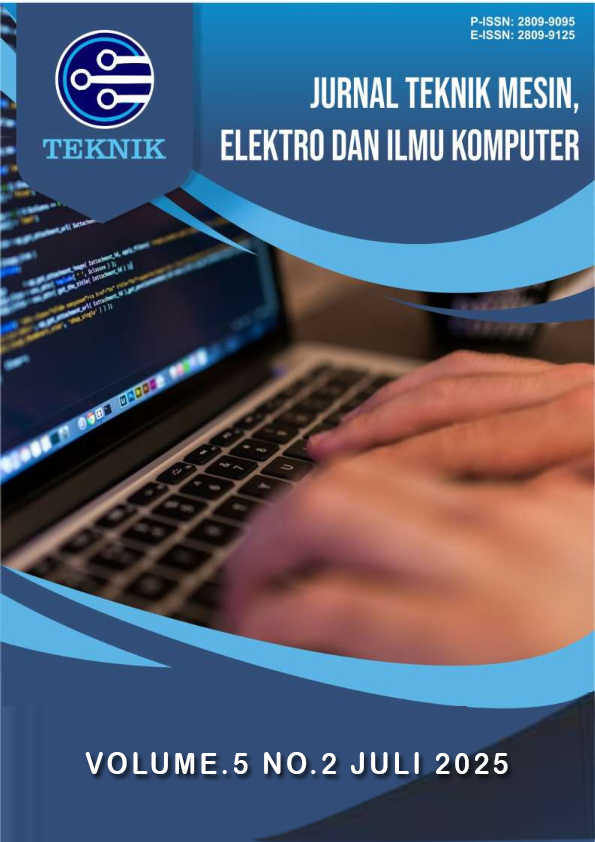Studi Numerik Aliran Fluida pada Elbow 90° dengan Variasi Geometri dan Bukaan Katup Menggunakan CFD Fluent
DOI:
https://doi.org/10.55606/teknik.v5i2.7177Keywords:
CFD, 90° elbow, pressure distribution, curvature radius, ANSYS FluentAbstract
Piping systems are critical components across various industrial sectors, including agriculture. The 90° elbow plays a key role in directing fluid flow; however, abrupt changes in flow direction within the elbow often lead to pressure losses and vortex formation, particularly in configurations with small curvature radii. This study aims to analyze the fluid flow characteristics within a 90° elbow under different curvature radii (extreme, R30 mm, and R50 mm) and various valve opening conditions, using numerical simulation based on Computational Fluid Dynamics (CFD) in ANSYS Fluent 2019 R3. The simulation results show that increasing the curvature radius leads to a more uniform pressure distribution along the bend and a reduction in vortex formation. Although larger valve openings increase flow velocity and Reynolds number, the pressure and velocity contours do not exhibit significant changes in flow patterns. This study confirms that elbow geometry design greatly influences the hydrodynamic efficiency of piping systems and can help minimize the risk of damage due to uneven pressure distribution
References
Abuhatira, A. A., Salim, S. M., & Vorstius, J. B. (2021). Numerical Simulation of Turbulent Pipe Flow With 90-Degree Elbow Using Wall Y+ Approach. ASME International Mechanical Engineering Congress and Exposition, Proceedings (IMECE), 10(January 2022). https://doi.org/10.1115/IMECE2021-69986
Alabdalah, A., & Wnos, L. (2020). Numerical Simulation and Flow Analysis of a 90-Degree Elbow. International Journal of Civil, Mechanical and Energy Science, 6(4), 10–13. https://doi.org/10.22161/ijcmes.64.1
Banerjee, A., & Mazumdar, J. (2024). A numerical investigation on rheological turbulent flow through a 90° mixing elbow. Journal of Engineering and Applied Science, 71(1), 1–25. https://doi.org/10.1186/s44147-024-00547-y
Çengel, Y. A., & Cimbala, J. M. (2006). FLUID MECHANICS: FUNDAMENTALS AND APPLICATIONS. In McGraw-Hill (United States).
Lin, P., Lei, D., & Liao, J. (2021). Study on the influence of elbow with different curvature radii on pipeline leak location. Advances in Mechanical Engineering, 13(10), 1–12. https://doi.org/10.1177/16878140211053424
Liu, D., Du, K., Qin, S., & Zhou, X. (2021). Numerical simulation of flow characteristics in vertical elbows of pneumatic conveying. Vibroengineering Procedia, 39(1), 146–151. https://doi.org/10.21595/vp.2021.22225
Salvatierra-Rojas, A., Ramaj, I., Romuli, S., & Müller, J. (2021). CFD-simulink modeling of the inflatable solar dryer for drying paddy rice. Applied Sciences (Switzerland), 11(7). https://doi.org/10.3390/app11073118
Shi, X., Chai, Y., Chen, H., Tao, H., & Jin, Q. (2024). Numerical simulation of pressure loss and flow characteristics in combined elbow pipes for solid-liquid two-phase flow. Water Science and Technology, 90(4), 1099–1114. https://doi.org/10.2166/wst.2024.262
Smyk, E., Stopel, M., & Szyca, M. (2024). Simulation of Flow and Pressure Loss in the Example of the Elbow. Water (Switzerland), 16(13). https://doi.org/10.3390/w16131875
Trivedi, A., Kumar, R., & Gautam, A. V. (2023). Background : 13, 4573–4592
Downloads
Published
How to Cite
Issue
Section
License
Copyright (c) 2025 Jurnal Teknik Mesin, Elektro dan Ilmu Komputer

This work is licensed under a Creative Commons Attribution-ShareAlike 4.0 International License.








